#at least i have a general design for kian. kind of
Text

idk i kinda wanted to draw more but i was rlly struggling. anyways.
#📚 my posts#🖍️ art#just roll with it#jrwi blood in the bayou#kian stone#at least i have a general design for kian. kind of#kian imposter mode shifts from blue to green#the butterfly becomes a spider and the roses probably turn to some bayou equivalent#the fluffy part of the guitar pick earring looks like webbing#do u think kian used to wear a rosary when he was younger?#i can imagine kian used to go to church on his own every now and again. to get away from his parents for a bit#cultt stuff was going on with them it was the lesser of two evils#fucked with his head tho
17 notes
·
View notes
Text
Hyperallergic: A Taste of the Complex Relationship between Chinese Food and Identity in America
Installation view of Sour, Sweet, Bitter, Spicy: Stories of Chinese Food and Identity in America at the Museum of Chinese in America (all photos by the author for Hyperallergic)
When my family lived in Montgomery, Alabama, in the mid ’90s, my mother would send me and my sister to school with lunch in the form of hot noodles in a thermos or fried rice in Tupperware. As we were pretty much the only Chinese kids — and immigrants — in our grades, her attempts to comfort us with memories of home back in Singapore were short-lived: our classmates would wrinkle their noses at the strange smells; not even my sister’s affinity for eating her noodles with ketchup could save her. I remember frequently receiving Handi-Snacks in my Pocahontas lunch box, an apparent attempt to win social acceptance for which I’ll never forgive my mom, although I know four-year-old me sure as hell relished that artificial cheese.
“Didn’t want you both to feel displaced,” she recently texted me, when I asked about that year of calculated lunch decisions in the South. “As long as they were not recognizable peanut butter and jelly sandwiches or Lunchables, your lunch would be considered ewwww.”
Sculpture by Heidi Lau
Chinese food has deeply shaped my experience growing up in America, in ways that are tough but also wonderful (and tasty) to remember. These memories from Alabama; Washington, DC; and my current home in New York flooded back when I visited Sour, Sweet, Bitter, Spicy: Stories of Chinese Food and Identity in America, an intimate and thoughtfully designed exhibition at the Museum of Chinese in America (MOCA). Its title, drawn from a Chinese saying, nods to the role food has played as a source of hardship and joy for Chinese people navigating this country’s challenging cultural landscape. Far more than simply providing nutrition, Chinese dishes have served as vital sustenance for the self, helping us develop our relationships, memories, and identities.
At MOCA, an elegant fusion of oral histories and visual art exemplifies Chinese food as a signifier of the familiar and the foreign. The show smartly adopts the form of a banquet to explore contemporary conversations about the cuisine and its related identities. Table settings offer tastes of the personal, food-based memories of 33 chefs from around the country, all but three of whom are of Chinese descent.
Their culinary biographies, printed and displayed like menus, convey their diverse backgrounds as well as their inspirations, signature dishes, ultimate comfort foods, and essential ingredients. Spread across the table are sculptures by artists Heidu Lau and Lu Zhang that resemble dishes, each of which encapsulates the complexities of Chinese- and Chinese-American food and identity in striking colors and alluring form. The smaller works draw inspiration from the chefs’ stories, visualizing their diverse relationships to Chinese food; the larger ceramics, positioned on functioning Lazy Susans, are glistening tributes to 18 regional cuisines, from Cantonese to Fujian and even Chino-Latino, evoking and weaving together characteristics of each place such as renowned dishes, architecture, and landscapes. Lau’s representation of Beijing recalls the architecture of the Forbidden City and integrates decadent gold paint and slices of sculpted Peking duck. Next to it, Lu’s vision of Zhejiang cooking takes the form of a local bridge, over which march little chunks of the region’s popular dish, braised pork belly.
Installation view of Sour, Sweet, Bitter, Spicy: Stories of Chinese Food and Identity in America at the Museum of Chinese in America
Sculpture by Heidi Lau
As with any memorable meal, you can’t digest all this splendor without meaningful conversation. A four-wall video installation surrounds the table, playing interviews conducted by curators Audra Ang, Kian Lam Kho, Andrew Rebatta, and Herb Tam with the featured chefs. Their voices, incredibly varied and spanning generations, touch upon everything from their upbringings and new lives in America to their paths towards current cooking styles. In another room, objects from their kitchens, such as charred woks and mooncake molds, further speak to years of labor.
Among those featured are Shanghai-born Cecilia Chiang, a renowned restaurateur who fled her country in the 1950s for San Francisco, where she introduced Americans to authentic Chinese food; Chinese-Americans Yvonne and Mike Thompson, who serve Asian-influenced Southern comfort food (think Velveeta egg rolls and parmesan wontons) at their Virginia eatery; and BiYing Ni, a cook from the fishing village of Fuzhou who continues to prepare Cantonese food for friends and family in her present home, New York. Many Chinese visitors will relate specifically to their shared memories, which include moments like eating duck at Thanksgiving, encounters with peanut butter, and being the only Chinese kid in class. Yet, in touching on themes of alienation and comfort, they also resonate with anyone who’s lived in a foreign setting.
Sculpture by Lu Zhang
Sculpture by Heidi Lau
The chefs’ stories relay the complex, unpinnable definition of “Chinese food,” evolving as it is, along with our understanding of it, as we adapt to different environments. And the exhibited spread affirms the diversity of the cuisine, with sculptures created in an array of shapes, textures, and colors. As informational text emphasizes, Chinese food is so much more than those dishes endemic in the popular, standard eateries — Lo mein, chow mein, and variations on chicken doused in sauces in every shade of orange.
What’s particularly refreshing about Sour, Sweet, Bitter, Spicy is that prior knowledge will only get you so far. The show is welcoming, situating us all, in a way, as newcomers to this feast. Lau and Lu’s cryptic sculptures set viewers on an even plane of knowledge and interpretation: The ceramic pieces don’t simply replicate identifiable dishes; they demand careful scrutiny to pick out familiar details — shrimp tails here, soft cabbage leaves there, one egg roll painted black and broken to reveal golden guts. Taken in its entirety, each is an enigmatic meal that nods to the continued evolution of Chinese cuisine as shaped by the lifestyles of the Chinese diaspora. The artists have also devised a kind of matching game to further educate visitors: the style of each large-scale sculpture reflects that of at least one smaller sculpture, so connecting visually similar dishes teaches you about the specific traits of the different cuisines.
The pairings also suggest how chefs have placed their own individual spins on tradition — a more sophisticated version of what my sister was doing with her mixture of noodles and ketchup. Each of us has our own definition of Chinese food in America; what we need to overcome is letting food define Chinese people in America in ways that assume and limit. Sweet, Sour, Bitter, Spicy not only opens your eyes to the kaleidoscope nature of this cuisine, but also leaves you hungry to taste it all.
Sculpture by Lu Zhang
Sculpture by Heidi Lau
Sculpture by Lu Zhang
Sculpture by Lu Zhang
Sculpture by Heidi Lau
Sculpture by Heidi Lau
Sculpture by Lu Zhang
Sculpture by Heidi Lau
<
Sculpture by Heidi Lau
Installation view of Sour, Sweet, Bitter, Spicy: Stories of Chinese Food and Identity in America at the Museum of Chinese in America
Installation view of Sour, Sweet, Bitter, Spicy: Stories of Chinese Food and Identity in America at the Museum of Chinese in America
Installation view of Sour, Sweet, Bitter, Spicy: Stories of Chinese Food and Identity in America at the Museum of Chinese in America
Installation view of Sour, Sweet, Bitter, Spicy: Stories of Chinese Food and Identity in America at the Museum of Chinese in America
Installation view of Sour, Sweet, Bitter, Spicy: Stories of Chinese Food and Identity in America at the Museum of Chinese in America
Sour, Sweet, Bitter, Spicy: Stories of Chinese Food and Identity in America continues at the Museum of Chinese in America (215 Centre Street, Chinatown, New York) through September 10.
The post A Taste of the Complex Relationship between Chinese Food and Identity in America appeared first on Hyperallergic.
from Hyperallergic http://ift.tt/2q20Xe1
via IFTTT
0 notes
Text
Week 9 - Forum Responses
To Sean Poon in [Objects,] Talk to Me:
Hey Sean, love the Housekeeping quote – one of my favourite novels.
“Why must we be left, the survivors picking among the flotsam, among the small, unnoticed, unvalued clutter that was all that remained when they vanished, that only catastrophe made notable?” – Marilynne Robinson, Housekeeping
I like the grounding of your work in a local context, and it's great that you mention Rem Koolhaas; you might want to draw upon his essay, Singapore Songlines: Portrait of a Potemkin Metropolis… or 30 Years of Tabula Rasa, which expounds on themes that could be interwoven with what you propose. He speaks of Singapore as being built up from blank slate, with landmarks and histories erased, whole communities uprooted and moved for the construction of a pristine, generic, artificial, and regulated First World city. I imagine some historical parallels may be drawn to the hidden demographics of which you speak – what communities are written over in the palimpsest of state-sanctioned narratives? What are the "hidden transcripts" that may emerge from our engagement with these communities and histories? Singapore is not a mere "Potemkin city", as Koolhaas may have written.
A summary of the essay may be found here http://www.qlrs.com/essay.asp?id=805
While your work centres on the idea of certain objects as being replete with significance vis-à-vis contestation of space, I do feel like space and architecture are particularly salient themes in what you propose – I'm thinking of local artist Debbie Ding's work, Rules for the Expression of Architectural Desires, which is a collection of speculative rules and schemes for the urban design of a city, accompanied by a video work. It considers our relationship to built urban environments; how its supposed materiality manifests in entirely immaterial concepts and urban experiences. It might be interesting to juxtapose these themes with the experience of the hidden demographics you mention.
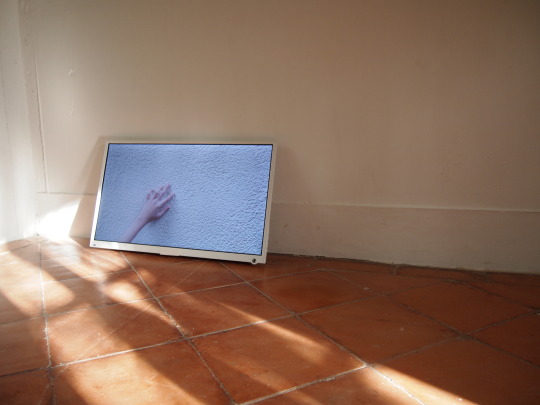
Debbie Ding's Architectural Desires (2015)
[Image source: http://dbbd.sg/works/architectural-desires.php]
The video work may be viewed at https://youtu.be/d59H6uIE0sM
Hopefully the works I recommend aren't too tangential and are at least of some interest to you. All the best for your project – sounds really promising.
To Geraldine Gan in Digital Marketing / Cyberbullying / Digital Interior Design:
Hey Geraldine -- I find your desire to combine concepts of marketing and recycling a unique synthesis. I see lots of potential for an artwork dealing with themes of environmentalism -- local artist Ong Kian Peng's Too Far, Too Near deals with the issue of climate change by creating an immersive space within which a viewer may contemplate global warming. A 2-channel video displays the image of melting glaciers, while electronic components and metal structures with metal balls slowly tilt and create subtle noises reminiscent of ice shifting and dissipating.
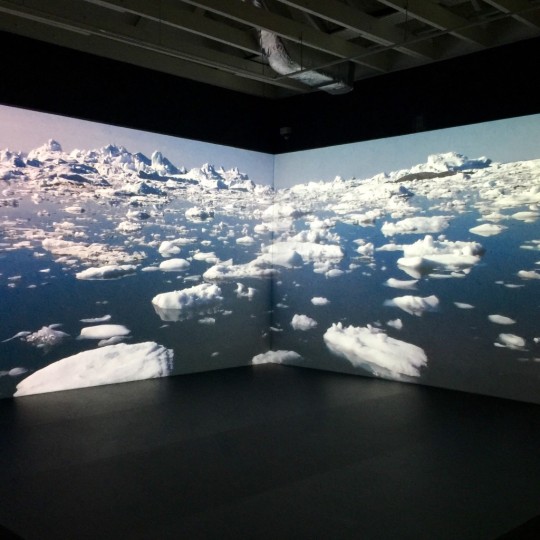
Ong Kian Peng, Too Far, Too Near, 2015, DC Motor, Metal balls, Steel structure; 2-channel video with 3-channel sound, Dimensions variable, Duration: 15 mins. [Image source: http://www.artitute.com/2015/09/27/singapore-got-art-talent-a-closer-look-at-the-2015-edition-of-the-presidents-young-talent/]
Perhaps this may give you an idea of how to go about creating spatiality even with two-dimensional videos, as Jacquelyn has raised as a point -- tapping on electronics and digital mediums to manipulate space and sense.
The idea of marketing can perhaps be linked to greater themes of capitalism and consumption -- though such are concepts often seen counter to environmentalism. I recommend the book This Changes Everything: Capitalism vs. the Climate by Naomi Klein, which touches upon the idea that the power of corporations (fueled by capitalism) prevents serious reforms to stop climate change and protect the environment.
To Aloysius Kow in Our everyday society:
Hey Aloysius -- interesting that you're applying the concept of surrealism to contemporary contexts and narratives. Here are some local artists that have dealt or drawn upon the iconography of everyday local scenes and abstracted them into something surreal or absurd.
Local artist Dorcas Ng's work, Commoners, was inspired by looking up at HDB buildings at night -- the lights and silhouettes from each unit suggesting a presence and an entire narrative we are not privy to. To elicit this same sense of curiousity and wonder borne from observation of everyday space, she created three box-like sculptures with electronic elements such as flashing lights or kinetic mechanisms, creating surreal, dreamlike re-imaginings of the HDB space. They are displayed in a specific manner: hung up high near the ceiling, such that guests must peer into each surreal HDB space from below, recreating the idea that we are catching a glimpse into lives different from our own. Ordinary becomes dream space, with each sculpture accompanied by a peculiar narrative written by the artist --
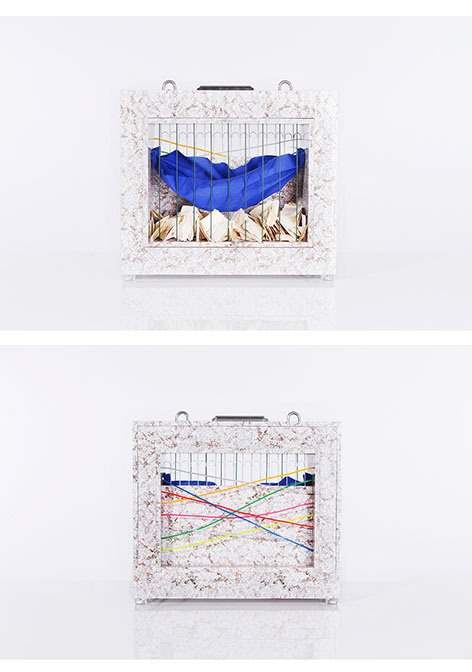
[Image source: http://www.aheeoee.info/COMMONERS]
Commoner A
Wood, metal, fabric, electronics
2015
"Commoner A wants to enter the lucid dream state in a quicker time. He decides on a hammock as a representational medium to transcend states of consciousness. Plus he is in deep need of active inspiration due to the nature of his job (without the need for drugs). 'One needs to constantly work hard at being creative.'"

[Image source: http://www.aheeoee.info/COMMONERS]
Commoner B
Wood, metal, fabric, electronics
2015
"Commoner B is moving out, albeit secretly. Large careless movements will alert the big-mouthed neighbours and chaos will ensue. The laundry should act as a good cover for all this commotion. 'Rain or shine, leave the laundry out.'"
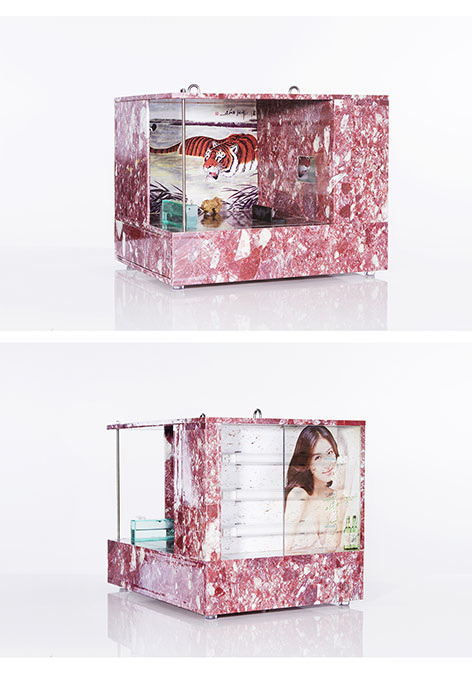
[Image source: http://www.aheeoee.info/COMMONERS]
Commoner D
Wood, metal, stone, electronics
2015
"With a ceiling high mural of a Chinese tiger in the living room you can kind of imagine the ferocity and desires of Commoner D. Living behind a billboard doesn't make his life easy in fact his speech and behaviour have to be carefully planned to avoid being caught. 'No traces should be lying around not even in my habitat.'"
As such, her works demonstrate an engagement with contemporary local images (the HDB) along with stories (imagined narratives of heartlanders).
Another work playing with the iconography of everyday objects and scenes from a local context is Kray Chen's Waiting on a Bird, which is a sculpture and video work reminiscent of a mahjong game -- except all four players are waiting for the same single tile which is nowhere to be found but on the television screen before them, a game that is impossible to win. Again, the everyday is taken and transformed into an absurd, surreal situation.
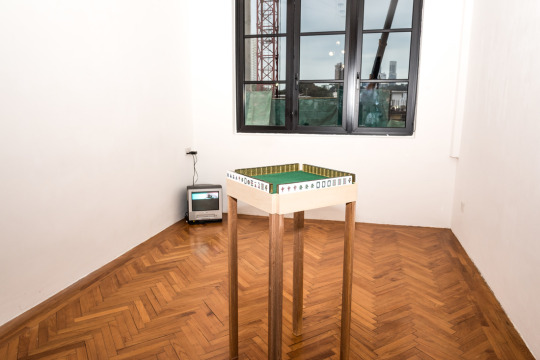
[Image source: http://www.kraychen.com/fortune-by-chance.html]
I suppose these artworks would guide how I would approach creating an artwork regarding the context of contemporary Singapore society -- taking images or situations that have significance to us and abstracting or distorting them to create a surreal situation that invites viewers to pause and ponder. These works can then be the entry point to several narratives, whether subtle or embedded within the artwork itself.
Hope these references give some ideas! Do check out more works by local artists, I imagine a lot of the themes they deal with are particularly salient to our lives.
Individual Forum Post
““[W]e’re suffering from brain fade. […] The flow is constant, […] Words, pictures, numbers, facts, graphics, statistics, specks, waves, particles, motes.” - Don Delillo, White Noise
I am interested in the idea of informational saturation as brought about by digital culture -- emerging from a desire to pay homage to the concept of brain fade as outlined within Don Delillo's novel, White Noise. Satirising consumer culture, one aspect of the novel is the constant barrage of information faced by the modern individual vis-à-vis mass communication. A continual sense of anxiety, along with the overall impotency of the modern individual in coping with this saturation is frighteningly well expressed. One can only extrapolate the extent to which these feelings may have grown with the advent of new media. Building upon these concepts explored in task 1, I wish to step beyond the concept of individual identity as affected and effected by these flows of information and wish to examine them within the greater general context of Singapore.
I am particularly interested in the idea of communities existing within these flows of information -- as imagined explorers, the sea people of an informational age, attempting to navigate tides of information. This plays upon the Manuel Castells' concepts of the space of flows, wherein physical space is seen as site for physical infrastructure allowing for metaphysical informational mobility -- here, playfully reimagined are these informational "flows" as something far more tangible and elemental; as if traversing oceanscapes.
This is inspired by Hito Steyerl's work, Liquidity Inc., wherein themes of capitalism and financial flows are expressed through the metaphor of water. The reimagining of human constructs such as markets, information, and data as manifest in a natural form such as water is an interesting, if absurd exercise.

Hito Steyerl, still from ‘Liquidity Inc.’ (2014). Image source: http://www.aqnb.com/2014/03/05/hito-steyerl-the-ica-liquidity-inc/
The artwork I hope to develop will be an attempt at abstracting and distorting these informational flows and saturation, demonstrating the desperate attempt to integrate these flows into a bearable form of existence. Perhaps we can ask ourselves what are the ways in which we cope -- or fail to cope -- or do not need to cope -- with the constant flows of information we receive on a daily basis, and how these experiences can be expressed in an abstracted form.
0 notes